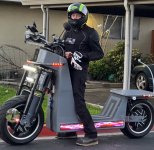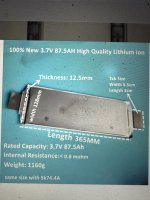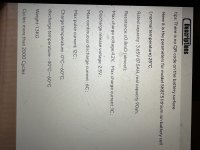After sizing my project for battery space, I'm considering using a hub motor vs the existing shaft drive on my GSX1100G. The 9" diameter x 14" long 80KW direct drive motor has several drawbacks:
1) It looks to be really expensive ($5,400 motor & controller) vs about $2,300 for the 17x4.5 12~14KW below.
2) It would require a u-joint to mate the bike's shaft drive to the motor shaft. While I'm sure this could be fabbed, it's an additional cost.
3) The motor (or even a smaller diameter/shorter one) eats up room I need for batteries. Since my bike has an upper & lower fairing, I am limited on how wide a battery pack can stick out up front.
The most common 12KW version hub drive comes on a 17x6.0 width rim. I have a nearly new 160/70-17 rear tire on the bike, but from what I've read it can only be used up to 5.5~5.75" wide rims. The minimum size shown on the QS site is 180/55, which is a shorter & wider tire. AFAIK, my OEM rim is 4.5~5" wide (caliper measurement on outside of rim bead area but not the widest part). A basic search showed the common 17" hub motor rims are either 3.5" for the 3KW~8KW or 6" for the 10KW/12KW.
While I was typing this, I saw QS Motor is a member here and had a hub drive thread that began in 2015. I saw there was a "new" 17x4.5 12KW fluid cooled hub motor, and apparently there was/is a 14KW version. The hyperlink there didn't work, but I found a current listing on Ali Express that says it is no longer available:
https://www.aliexpress.us/item/2251832816692903.html?gatewayAdapt=glo2usa4itemAdapt. There is a listing on Alibaba.
Specs are favorable for my application. Fluid cooling for the motor and if needed for the controller would be relatively easy since my bike has a large oil cooler up front (Suzuki Advanced Cooling System). It's also rated for higher speed (170KMH or 105MPH) than the 6" version. I'd like to find out if anyone here has used this particular hub drive.
Finally, I'd like to find out of this 12~14KW motor would be sufficient for 800 pounds of rider and bike at freeway speeds (70-80 MPH sustained). The specs on the QS site for both versions claim torque of 200 – 350N.m, which is far more than my 1127cc ICE ever made (99 peak).
1) It looks to be really expensive ($5,400 motor & controller) vs about $2,300 for the 17x4.5 12~14KW below.
2) It would require a u-joint to mate the bike's shaft drive to the motor shaft. While I'm sure this could be fabbed, it's an additional cost.
3) The motor (or even a smaller diameter/shorter one) eats up room I need for batteries. Since my bike has an upper & lower fairing, I am limited on how wide a battery pack can stick out up front.
The most common 12KW version hub drive comes on a 17x6.0 width rim. I have a nearly new 160/70-17 rear tire on the bike, but from what I've read it can only be used up to 5.5~5.75" wide rims. The minimum size shown on the QS site is 180/55, which is a shorter & wider tire. AFAIK, my OEM rim is 4.5~5" wide (caliper measurement on outside of rim bead area but not the widest part). A basic search showed the common 17" hub motor rims are either 3.5" for the 3KW~8KW or 6" for the 10KW/12KW.
While I was typing this, I saw QS Motor is a member here and had a hub drive thread that began in 2015. I saw there was a "new" 17x4.5 12KW fluid cooled hub motor, and apparently there was/is a 14KW version. The hyperlink there didn't work, but I found a current listing on Ali Express that says it is no longer available:
https://www.aliexpress.us/item/2251832816692903.html?gatewayAdapt=glo2usa4itemAdapt. There is a listing on Alibaba.
Specs are favorable for my application. Fluid cooling for the motor and if needed for the controller would be relatively easy since my bike has a large oil cooler up front (Suzuki Advanced Cooling System). It's also rated for higher speed (170KMH or 105MPH) than the 6" version. I'd like to find out if anyone here has used this particular hub drive.
Finally, I'd like to find out of this 12~14KW motor would be sufficient for 800 pounds of rider and bike at freeway speeds (70-80 MPH sustained). The specs on the QS site for both versions claim torque of 200 – 350N.m, which is far more than my 1127cc ICE ever made (99 peak).




